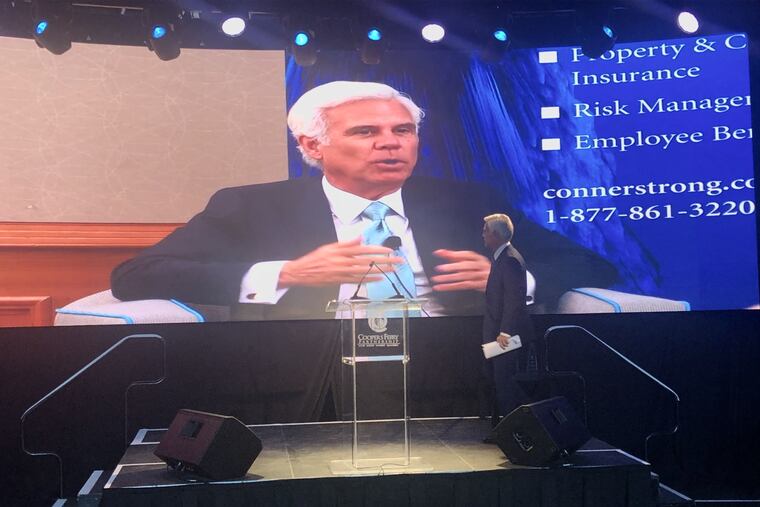The future of Camden, according to George Norcross
The Cooper University Hospital board chairman, insurance executive, and longtime South Jersey political leader George E. Norcross 3d described a Camden on the rise at a meeting Tuesday of the Cooper's Ferry Partnership.

With an enormous digital image of himself as a backdrop, George E. Norcross 3d strode onstage in front of several hundred people at Camden’s BB&T Pavilion.
The power broker widely viewed as Camden’s unofficial CEO/unelected political chief had just been introduced by Mayor Frank Moran as “a businessman, a health-care visionary, a philanthropist … and one of the strongest advocates this city has ever had … and a friend to the people of the great city of Camden."
The mayor, a hardworking fellow who owes his political career to the mighty Democratic Party organization Norcross built, might also have introduced the tanned, silver-haired keynote speaker as spinmaster and storyteller-in-chief.
Because for the next 40 minutes of the Cooper’s Ferry Partnership’s annual meeting Tuesday, Norcross delivered an assiduously, even passionately, upbeat lecture about the city on which he has exerted a profound influence for decades.
“Camden," he declared, “is undergoing an extraordinary renaissance."
His buoyant, buzz-wordy narrative highlighted the importance of the city’s people and its neighborhoods, rather than playing up the redevelopment projects downtown and along the Camden Waterfront, such as the skyscraper that upon completion this year will the headquarters of Norcross’ insurance company.
During Norcross’ remarks, the digital screen was filled with attractive images of city residents, most of them people of color. The BB&T lobby featured impressive Cooper’s Ferry promotional displays with an “Explore/Engage/Empower Camden” theme.
The imagery seemed designed at least in part to counter criticism of Camden’s ongoing redevelopment explosion as having little to do with — and few direct benefits for — people who actually live in the city, where whites make up less than 10 percent of the population of 77,000.
Norcross made ample use of the word extraordinary as he outlined a bottom-up, rather than top-down, redevelopment effort since 2010 in which new schools, parks, and safer neighborhoods mattered more than big development deals.
"We realized civic engagement was vitally important,” Norcross said. “Many of us set out and spent time meeting with neighborhood groups and religious leaders and civic organizations, talking about what needed to be done to make this city turn around.”
His audience — surely the whitest to be found anywhere in town since September’s Ozzy Osbourne concert at the same venue — was respectful as only a handpicked assemblage could be.
I’ve attended many of these Cooper’s Ferry shindigs over the years and never before noticed so much security: Streets blocked off, IDs checked, and cops (one of whom I overheard talking about the potential for protests) stationed all over the place.
But nary a discouraging word was heard inside the BB&T, despite the recent spate of not-so-good Camden news.
Last July, Liberty Property Trust — a Philadelphia-based company that’s a major player in commercial real estate nationwide — announced it would write down the value of its Camden Waterfront development by $26 million, due to lower-than-anticipated demand for office space there.
Two months later, Holtec International founder and CEO Krishna “Kris” Singh was quoted by a New Jersey business publication bemoaning a lack of job readiness among people in Camden. This touched off a protest outside the mammoth manufacturing complex Holtec built in South Camden after receiving a $260 million state tax credit largely predicated, at least in part (or in theory), on local job creation.
And in January, Gov. Phil Murphy, a North Jersey millionaire Democrat unbeholden to Norcross, used much of his State of the State address to assail these same incentives. “This is about wasted money, phantom jobs, squandered opportunities, and misplaced priorities,” said the governor, who had ordered an audit of the program.
Murphy did not mention Camden by name during his speech, and on Tuesday, Norcross did not name the governor while defending the incentives — and offering lavish praise for Murphy’s Republican predecessor, Chris Christie.
“He saved this city,” Norcross declared, to polite applause.
As for the incentive programs Murphy intends to revamp or replace, Norcross said they haven’t been a cash bonanza but rather a tool to entice companies to come to or expand in a city long short on private capital.
Norcross also said the incentives include a “clawback” provision should the expected job creation not materialize. But neither he nor Moran mentioned the effort, announced in the wake of the Holtec protest, to boost the hiring of city residents at companies awarded the incentives.
Winding up his presentation, the keynote speaker offered a dramatic flourish.
“This is our last chance,” Norcross said. “Failure is not an option. We will not fail.”